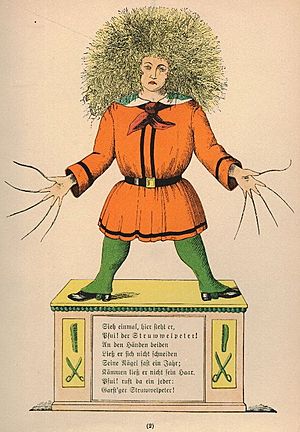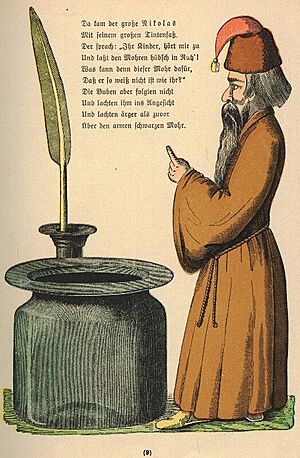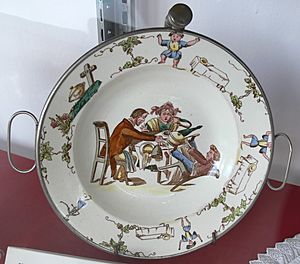Struwwelpeter facts for kids

Struwwelpeter in a 1917 edition.
|
|
| Author | Heinrich Hoffmann |
|---|---|
| Working title | Lustige Geschichten und drollige Bilder mit 15 schön kolorierten Tafeln für Kinder von 3–6 Jahren |
| Illustrator | Heinrich Hoffmann |
| Country | Germany |
| Language | German |
| Subject | Cautionary tales |
| Genre | Children's book |
|
Publication date
|
1845 |
| Followed by | König Nussknacker und der arme Reinhold |
Der Struwwelpeter ("Shock-headed Peter") is a famous German children's book from 1845. It was written by Heinrich Hoffmann. The book has ten illustrated stories with rhymes. Most stories are about children. Each story teaches a clear lesson. It shows the bad things that can happen if children misbehave. The first story's title gave the whole book its name. Der Struwwelpeter was one of the first children's books to mix pictures and words. Because of this, it is seen as an early version of comic books.
This book is also known for introducing the character of the Tailor, or Scissorman.
Contents
The Stories in Der Struwwelpeter
- Struwwelpeter: This story is about a boy who does not take care of himself. He doesn't brush his hair or cut his nails. Because of this, no one wants to play with him.
- The Story of Wicked Frederick: Frederick is a mean boy. He hurts animals and people. One day, a dog bites him. While Frederick is sick in bed, the dog eats all his food.
- The Very Sad Tale with the Matches: A girl named Pauline plays with matches. Her cats warn her not to. But she does not listen. She accidentally sets herself on fire and sadly burns to death.
- The Story of the Inky Boys: Three boys make fun of a dark-skinned boy. Nikolas, a tall man, sees this. To teach them a lesson, he dips the three mean boys in black ink.
- The Story of the Wild Huntsman: This is the only story not mainly about children. A hare steals a hunter's gun and glasses. Then, the hare starts to hunt the hunter! The hunter falls into a well.
- The Story of the Thumb-Sucker: A mother tells her son Konrad not to suck his thumbs. When she leaves, he starts sucking them again. Suddenly, a tailor appears with giant scissors. He cuts off Konrad's thumbs.
- The Story of Soup-Kaspar: Kaspar is a healthy boy. But he says he will not eat his soup anymore. Over the next five days, he gets weaker and weaker. Sadly, he dies because he refused to eat.
- The Story of Fidgety Philip: Philip cannot sit still at dinner. He wiggles and rocks in his chair. He accidentally knocks all the food onto the floor. His parents are very unhappy.
- The Story of Johnny Look-In-The-Air: This boy always looks up at the sky. He never watches where he is walking. One day, he walks right into a river. He is saved, but his schoolbook floats away.
- The Story of Flying Robert: A boy named Robert goes outside during a storm. The strong wind catches his umbrella. It lifts him high into the air. The story ends with Robert flying far away.
Adaptations in Media
Der Struwwelpeter has inspired many plays, films, and songs.
Stage and Film
- A British play called Shockheaded Peter was shown in London in 1900.
- A ballet based on the book was created in Germany before World War II.
- A live-action film was made in Germany in 1955. In this movie, the bad things that happen to the characters are reversed.
- Little Suck-a-Thumb (1992) is a short film based on the thumb-sucking story.
- Shockheaded Peter (1998) is a British musical opera. It uses puppets and songs to tell the stories. It won many theater awards.
Comics
- German comic artist David Füleki has made several manga-style versions of Struwwelpeter. These include Struwwelpeter: Die Rückkehr (2009) and Struwwelpeter in Japan (2012).
- The Scissorman story was turned into a comic by Sanya Glisic in The Graphic Canon (2012).
Other Media Influences
- The book has been mentioned in many other stories and shows.
- In Astrid Lindgren's Pippi Longstocking (1945), there's a funny story about a boy who refuses to eat.
- Agatha Christie's novel Curtain (1975) mentions a character whose hair sticks up "like Struwwelpeter."
- Jamie Rix said the book inspired his Grizzly Tales for Gruesome Kids. He wanted to create similar scary stories for kids today.
- The fantasy novel The Fourth Bear (2006) starts with police trying to arrest the Scissorman.
- In the TV show The Office (2006), a character reads parts of the book to children.
- Family Guy (2009) has a short joke based on "The Story of Little Suck-a-Thumb."
- In Doctor Who (2017), The Doctor reads part of "The Story of the Thumb-Sucker" to children.
- The German band Rammstein has a song called "Hilf Mir" (2005). It is based on "The Very Sad Tale with the Matches."
- The British band Shock Headed Peters (formed in 1982) took their name from the book.
Struwwelpeter: Merry Tales and Funny Pictures at Project Gutenberg
See also
 In Spanish: Struwwelpeter para niños
In Spanish: Struwwelpeter para niños




